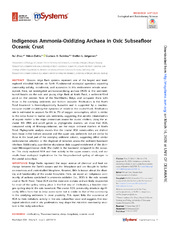| dc.description.abstract | Oceanic ridge flank systems represent one of the largest and leastexplored microbial habitats on Earth. Fundamental ecological questions regarding community activity, recruitment, and succession in this environment remain unanswered. Here, we investigated ammonia-oxidizing archaea (AOA) in the sedimentburied basalts on the oxic and young ridge flank at North Pond, a sediment-filled pond on the western flank of the Mid-Atlantic Ridge, and compared them with those in the overlying sediments and bottom seawater. Nitrification in the North Pond basement is thermodynamically favorable and is supported by a reactiontransport model simulating the dynamics of nitrate in the crustal fluids. Nitrification rate is estimated to account for 6% to 7% of oxygen consumption, which is similar to the ratios found in marine oxic sediments, suggesting that aerobic mineralization of organic matter is the major ammonium source for crustal nitrifiers. Using the archaeal 16S rRNA and amoA genes as phylogenetic markers, we show that AOA, composed solely of Nitrosopumilaceae, are the major archaeal dwellers at North Pond. Phylogenetic analysis reveals that the crustal AOA communities are distinct from those in the bottom seawater and the upper oxic sediments but are similar to those in the basal part of the overlying sediment column, suggesting either similar environmental selection or the dispersal of microbes across the sediment-basement interface. Additionally, quantitative abundance data suggest enrichment of the dominant Nitrosopumilaceae clade (Eta clade) in the basement compared to the seawater. This study explored AOA and their activity in the upper oceanic crust, and our results have ecological implications for the biogeochemical cycling of nitrogen in the crustal subsurface. | en_US |

